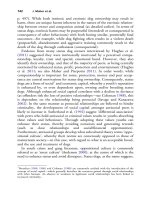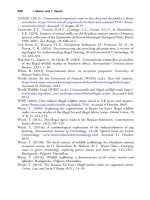The palgrave international handbook of a 256
Bạn đang xem bản rút gọn của tài liệu. Xem và tải ngay bản đầy đủ của tài liệu tại đây (27.78 KB, 1 trang )
252
R. White
Although the global rate of net forest cover loss has slowed, partly due to the
expansion of plantations and to natural forest restoration, forest biodiversity loss
continues to occur disproportionately since the highest levels of deforestation and
of forest degradation are reported for biodiversity-rich natural forests in developing countries. (United Nations Environment Programme 2011, p. 48)
Net losses are especially significant in South America and Africa.
Factors affecting deforestation, and reduction in forest biodiversity,
include unsustainable harvesting of forest products for industrial use and
livelihood needs, deforestation for agriculture, and severe drought and forest
fires. Every year some 10 million hectares of forest are destroyed, industrial
timber exports total around US$150 billion per year, and estimates of illegal
logging account for about 25 % of removals worldwide (Setiono 2007,
p. 27). Much of this illegal logging occurs with the involvement of corrupt
government officials, including law enforcement officers, financial institutions and backers, and business people who import timber or wood-base
products. Bribery and ‘goodwill’ payments, smuggling, illicit trafficking,
money laundering and forging of documents are all part of the illegal logging
industry (Bisschop 2015; Setiono 2007).
Deforestation and species reduction are not only solely the outcome of
logging. Land clearance is also due to agricultural exploitation, cattle farming, mining, oil and gas installations, and hydroelectric dams (see Boekhout
van Solinge 2008a, b, 2010a, b; Boekhout van Solinge and Kuijpers 2013;
Khagram 2004). There is also the phenomenon of ‘conflict timber’, associated with West Africa, for example, in which deforestation is linked to the
funding of civil wars and armed conflicts (Boekhout van Solinge 2008a;
Brisman and South 2013; Brisman et al. 2015). In these contexts, the
ecological impact of logging and land clearance transcends the legal-illegal
divide insofar as vast amounts of forest are destroyed in many different
locations—from Peru and Brazil, Liberia and Sierra Leone, to Indonesia
and Australia. The motivations, objectives and practices may vary depending
upon the social context and specific industry interests, but the result is
further depletion of many different kinds of trees and variety of forests.
Another reason for deforestation and biodiversity reduction is the increasing reliance on energy from organic sources, especially in the global North
(see Burrell et al. 2012; Charles et al. 2013). For example, global vegetable oil
supplies used for biodiesel production are on the increase because of
European and North American demand, with Indonesia and Malaysia
major producers in the Asian region (Mitchell 2008). This translates into
massive shifts in land use. Indeed, the profitability of biofuel production is









